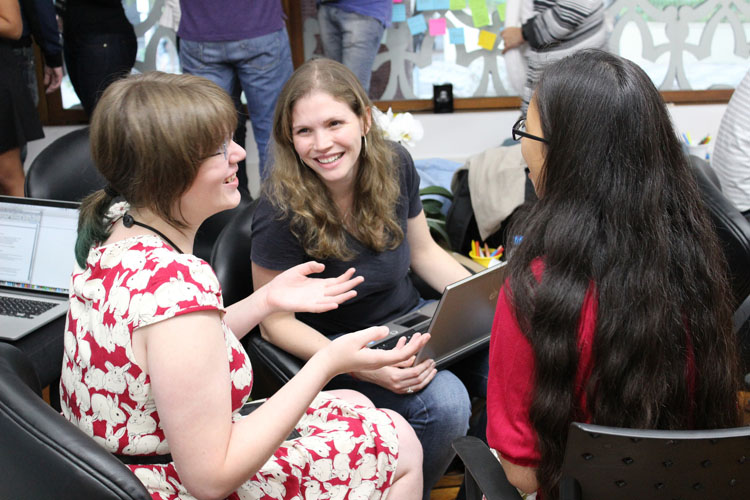Where are the women? In Brazilian fablabs…
Published 3 November 2014 by Fabien Eychenne
In the country of « fabrique você mesmo » (do it yourself), Brazilian fablabs and hackerspaces have a mixed public. Even though the maker world, in Europe at least, is still largely dominated by a masculine population, Brazil supposedly does better in terms of parity. Why?
(Sao Paulo, special envoy)
One of the first things that may be perceived when you come from Europe and you encounter Brazilian fablabs is the near egalitarian place filled by women. During workshops, events, debates and trainings, the public is generally mixed.
During the first Fabjam organised at the Garagem fablab, 7 out of 14 participants were women. The Flickr public of the Sao Paulo Garagem is composed of as many women as men. These observations could well seem caricatural, even macho, to any person unfamiliar with fablabs. One cannot but notice that in France and more generally in Europe parity is far from being reached.

To the best of our knowledge, no comprehensive statistical data exists on the public of fablabs on a worldwide scale. However we looked into the database of fablabs.io supported by the Fabfoundation. Dedicated to the fablab community, fablabs.io allows the declaration of labs by peer-to-peer approval. The founders, fabmanagers or persons associated to the fablab are then connected to the structure. They are therefore not the users but the creators of the place.
Gender and fablabs
This methodology does not claim to be perfect, especially given the small sample…Nonetheless, no figure exists to verify or contradict our feeling. The database of fablabs.io, the vocation of which is to take an inventory of all the fablabs, can be a good starting point to estimate the gender of fablab users. We counted and sorted by gender persons linked to places as they appear on Fablabs.io. Which gives us the following chart:

The figures speak for themselves: if perfect parity in Brazil is pure chance, the figures for the three other European countries show to what extent women are under-represented. Furthermore, in Brazil, out of the 10 existing structures, 3 were created by women: Fab lab Brazil Association, Fab lab Floripa and Olabi. In France only 2 labs out of 51 are lead by women: Kelle Fabrik in Dijon and La Fabulerie in Marseille.
The analysis is easy. It is however more difficult to assess the reasons. Update and types of digital fabrication workshops, the recent report published in France by the DGCIS (government competition industry and services department), gives some statistics on fabmanagers’ trainings. 20% have trained in design, communication and/or architecture, 58% have a technical, computing and/or industrial training. Difficult to extrapolate from these figures but several reports including one on the digital sector show that women are under-represented (only a quarter of jobs). This observation is also valid with engineers, a 17.4% feminine profession.
A public of designers and architects
Brazil hasn’t yet established figures on that subject. Interviews with the “fabmanageresses” and three women who founded labs in Sao Paulo emphasize the fact that designers and architects are the prime public of these labs. Several Brazilian fablabs that we visited are very education oriented with programs like Fablab Kids. They are also often less technical than those we have come across in France. Our experience of French fablabs shows that entrepreneurial project leaders as well as organisers imprint their personality on the fablabs. They often bring with them their own community of interest or training. This could explain the mixed public in the Brazilian fablabs.
Difficult however to draw firm conclusions. Will the presence of women remain as equal as the presence of men in Brazilian fablabs?
